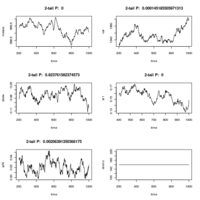

Single replicate. Almost all warning signals have significant correlation despite the constant environment.


False warning signals remain just as common when signals are averaged across 100 replicates?
- Exploring statistical qualification of early warning signals. Dakos et. al. (2008) use a correlation significance test (based on Kendall’s tau) on the autocorrelation to detect the warning signals.
- Correlation significance test seems a very poor estimate of signal, high false positive rate at any threshold p-value for sufficiently frequent sampling. Carpenter [1] Fits a dynamic linear model of the SD and argues it appears to trend up visually.
- Carpenter SR and Brock WA. . pmid:16958897. PubMed HubMed [Carpenter]
Detecting switch points vs gradual change? See change point estimation?
Data from Dakos et. al. study available from NOAA
Computing
- Just wrote the R interface. Faster than running the C code, generating a text file and reading it into Python (though could spend time with swig at some point).
- added a minimal version, popdyn.c, that just reads out raw data without all the on-the-fly statistics the full function does.
- Kendall statistics on metrics to determine warning signals. R function.
- Fixed the gillespie interface. Gillespie function does get passed the parameter structure, just makes an actual copy, allocating new memory, in the gillespie function rather than calling alloc for the first time.
Next Steps
- Will want to be able to adjust the rate of change in the environment from the R commandline.
- The parallelization compiler flags are included in makevars and called by R CMD SHLIB, but the .C call doesn’t seem to engage all processors. Exploring this with the r-sig-hpc list.
Alan Meeting
Goals:
- Purchase workstation by/before Sept 1st
- demonstrate simulations: Arbitrarily sensitive false alarms to oversampling
- review manuscript outline
- Discuss the bootstrapping model comparisons example from the Labrid dataset.
Further Reading
- Regarding the references, the statement about the “genericity” of the saddle-node bifurcation can be found in section 4.2 of Perko’s “Differential equations and dynamical systems” book. The CLT for stationary, ergodic sequences can be found in Durrett’s book “Probability: Theory and Examples”. (from Sebastian)
Workstation choices
- Sizing up options for our new computer server. Would be nice to be able to explore CUDA GPU computing, considering tesla and fermi (better double-precision performance) options. Other option, AMD released a 12 core chip, could possibly setup a 24 processor machine on two sockets. Getting comparisons from silicon mechanics. Ok, options under $5000 (after educational discount) are in:
- 2x Xeon Quad 2.4GHz, 12Mb Cache, 24GB RAM + Tesla C1060 active cooled
- 2x Opteron 6128 8-core, 2 GHz, 32GB RAM + Tesla C1060 active cooled
- 2x Opteron 12-core, 1.9 GHz, 32 GB RAM
- Available on 4U and 1U forms. the 24 core machine could add 1-2 GPUs later. The Tesla C2050 GPU is $1888 and is much better at double precision, while the Tesla C1060 is $950.
- Double precision vs single precision comparisons. C1060 does order of magnitude worse (933 vs 78 gigaflops) on single vs double precision. The C2050 gets (1040 GFLOPS single, 520 GFLOPS double). Looking into C2050 options…
- C2050, next gen/Fermi Release April 20th, we’ll see.